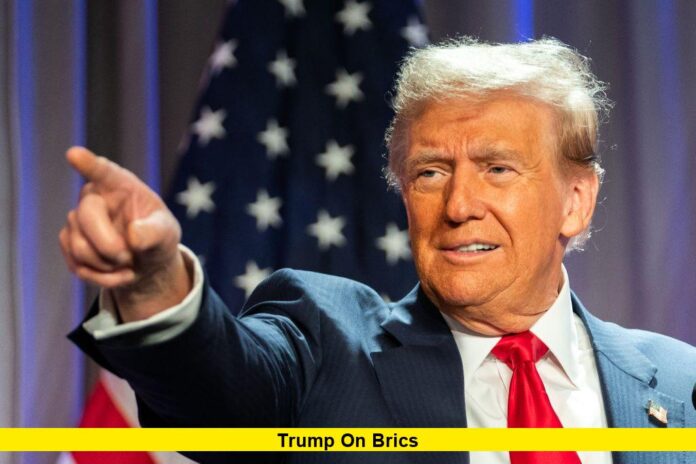In a move that has reignited global economic debates, former U.S. President Donald Trump has issued a stern warning: any country aligning with the BRICS countries could face an additional 10% tariff if he returns to office. This bold statement comes as the BRICS alliance continues to expand its global influence, particularly with new members and increasing coordination among member nations. Trump’s comments were shared publicly during a speech this past weekend, causing immediate reactions across financial markets and diplomatic circles.
Trump Targets BRICS Countries with Tariff Threat
Donald Trump’s message was direct—he intends to impose an extra 10% tariff on any nation supporting BRICS countries’ anti-American policies. While he didn’t specify which policies were considered “anti-American,” the implication was clear: any economic or diplomatic closeness to BRICS could be viewed as opposition to U.S. interests.
This announcement comes at a crucial time when BRICS countries—Brazil, Russia, India, China, and South Africa—are seen strengthening their political and economic influence. In recent months, the bloc welcomed countries like Iran, Saudi Arabia, and Egypt, signaling an expanding coalition aimed at reshaping global power structures.
Key Points Summary
- Trump threatens a 10% additional tariff on countries aligning with BRICS.
- The announcement sparked international concern among U.S. trade partners.
- Financial markets experienced immediate volatility following the statement.
- BRICS is rapidly expanding and presenting a unified global voice.
- Policy implications could unfold after July, with possible enforcement beginning August.
Why BRICS Countries Are Under Fire
Trump’s remarks suggest a broader strategy to isolate the BRICS countries diplomatically and economically. His campaign has repeatedly warned of the dangers of multi-national alliances that challenge the U.S. dollar, promote alternative trade settlements, and criticize U.S. foreign policies.
BRICS has been increasingly vocal in opposing unilateral Western sanctions and is exploring the creation of a new payment system to bypass the U.S. dollar. These moves are likely viewed by Trump and his allies as direct threats to American economic leadership.
Trade experts suggest that Trump’s approach could involve targeting both allies and neutral countries that engage in deals with BRICS nations, especially in energy, defense, and digital infrastructure sectors.
Potential Global Fallout and U.S. Policy Implications
If Trump’s tariff threats materialize, several countries—notably those with new BRICS ties—could be affected, including:
- Saudi Arabia: Recent BRICS member and oil trade giant.
- India: Strategic U.S. partner, but also a BRICS founding member.
- UAE & Egypt: Growing trade hubs with dual alignments.
- Brazil & South Africa: Traditional members of the bloc.
This policy shift could result in:
- Higher import costs for U.S. businesses sourcing from these nations.
- Diplomatic strains between the U.S. and several key trade partners.
- Greater push among BRICS countries to accelerate dollar-independent transactions.
Market Reactions and Economic Signals
Following Trump’s announcement, global financial markets showed signs of unease. While the dollar temporarily gained ground, emerging markets currencies dipped, and global trade indexes reflected increased caution. Businesses with cross-border operations are now awaiting more clarity, particularly those importing raw materials or electronics from BRICS-aligned nations.
Additionally, logistics companies and importers are evaluating supply chain risks should tariffs become a reality in 2025. This concern is compounded by the already tense trade environment caused by rising fuel costs and geopolitical disruptions.
BRICS Countries: Rising Influence, Rising Risk?
The rise of the BRICS countries has been one of the most watched trends in international relations. Their increasing cooperation on energy, trade, and technology has put pressure on long-standing Western institutions. Now, with Trump’s warning, the bloc may face more resistance but could also gain further solidarity from nations wanting to reduce dependency on the U.S.
Some analysts argue that Trump’s aggressive stance might backfire, pushing more countries toward BRICS in search of economic alternatives and independence from U.S.-dominated systems.
Conclusion
As global attention shifts to the evolving power dynamics between the U.S. and BRICS countries, Trump’s 10% tariff threat could mark the start of a more confrontational trade environment. With election season approaching and BRICS continuing its outreach, nations around the world must weigh the economic cost of alignment—either with Washington or with an increasingly assertive BRICS bloc.
For now, uncertainty looms. The next few weeks could see major announcements, especially with tariff enforcement possibly beginning as early as August. Businesses, policymakers, and diplomats are all watching closely, ready to adapt to what could be a dramatic shift in the global trade order.
